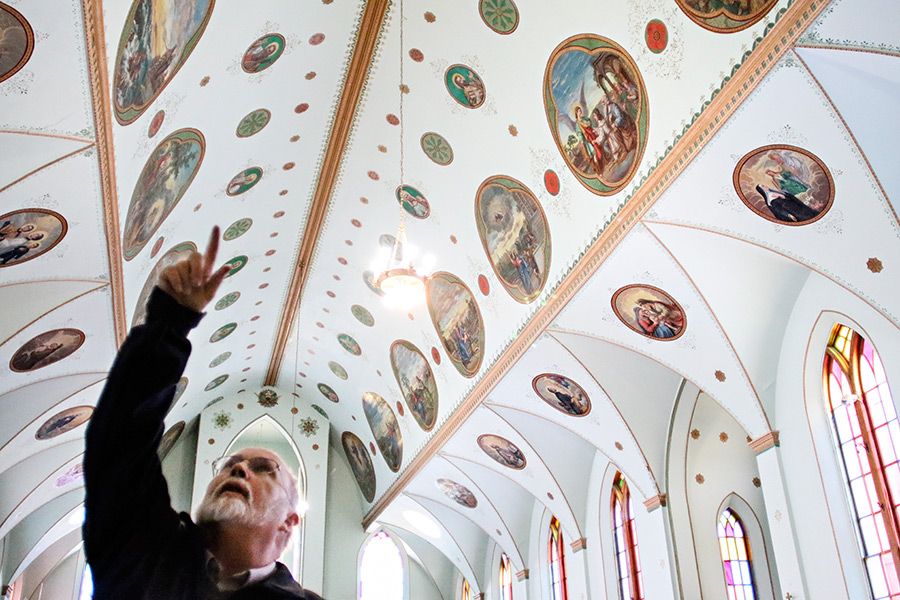ST. IGNATIUS – Father Andrew Maddock climbed up a set of wobbly stairs and dug into his pocket for his keys. After fiddling with the old lock, he opened the door and guided two visitors toward the heart of the historic St. Ignatius Mission: the altar.
On a cloudy December afternoon, light shone through the ancient stained glass windows and illuminated 58 murals depicting various biblical stories and characters.
“(These murals) have been here for more than 100 years and they bespeak of God’s grandeur,” Maddock said.
The frescoes are perhaps the most striking part of the historic St. Ignatius Mission, located about 40 miles north of Missoula on the Flathead Indian Reservation. And more than a century after an Italian-born Jesuit spent the better part of a year painting the murals, they are falling apart.
Chunks of plaster frequently fall off the murals and cracks now crisscross the paintings. Maddock, who has been at the church for 15 years, says something must be done to save the paintings before it’s too late.
The Jesuits founded the St. Ignatius Mission in 1854, a year before the Flathead Indian Reservation was formed. Within a year, nearly 1,000 Native Americans settled near the Mission, which had a chapel, a few cabins and some workshops. In later years, boarding schools and a hospital were established there in the shadow of the Mission Mountains.
In 1891, construction began on the Mission’s current church using locally made bricks. It took nearly two years to complete, but when it was done, the church bell tower reached nearly 100 feet into the sky.
When the church was finished, the interior was bare until Brother Joseph Carignano arrived in 1903. Carignano, an Italian who entered the Society of Jesus when he was 20, was assigned to missions in the Pacific Northwest. Carignano primarily worked as a cook, but he also had a knack for art and he painted murals in churches, schools and convents across the region, including at St. Francis Xavier in Missoula and the church in St. Ignatius.
The frescoes at St. Ignatius show scenes from the Old and New Testaments. The three most prominent paintings, located right behind the altar, show scenes from the life of St. Ignatius Loyola, after whom the community is named. Above the three scenes of St. Ignatius is an image of the Last Judgment, which is a depiction of the second coming of Christ. On either side of the altar are images of Mary and Joseph.
The paintings are more impressive when you consider that Carignano was an amateur artist.
“When he became a Jesuit, he had said he knew a little bit about art,” Father Maddock said, pointing to the murals at the church. “All it took was a little bit of talent to do all this.”
Now, 110 years after Carignano finished his works of art, they are starting to fall apart. Maddock said the paintings, particularly the ones behind the altar, began to crack a few years ago. The deterioration was partly caused when the altar’s back wall began to sink. In an effort to prevent it from sinking more, the church installed new cribbing below the altar last year.
This year, a team from New York-based EverGreene Architectural Arts arrived in St. Ignatius to stabilize the murals with temporary mesh. The mesh, which looks like cheesecloth, will keep pieces of the paintings from falling to the floor. However, much more needs to be done to permanently preserve the paintings. This month EverGreene Architectural Arts, which specializes in restoring plasterwork, is outlining a plan of what to do next. Maddock is unsure how much it will cost to restore the murals (the stabilization work in October cost more than $13,000).
The church has begun raising money for the project on Go Fund Me (https://www.gofundme.com/StIgnatius-Mission).
Maddock said he is hopeful that within a few years the mural will look just like it did when Carignano completed it more than a century ago.
“Carignano used his talents to build up the body of Christ,” the priest said. “That’s what we should all do.”
